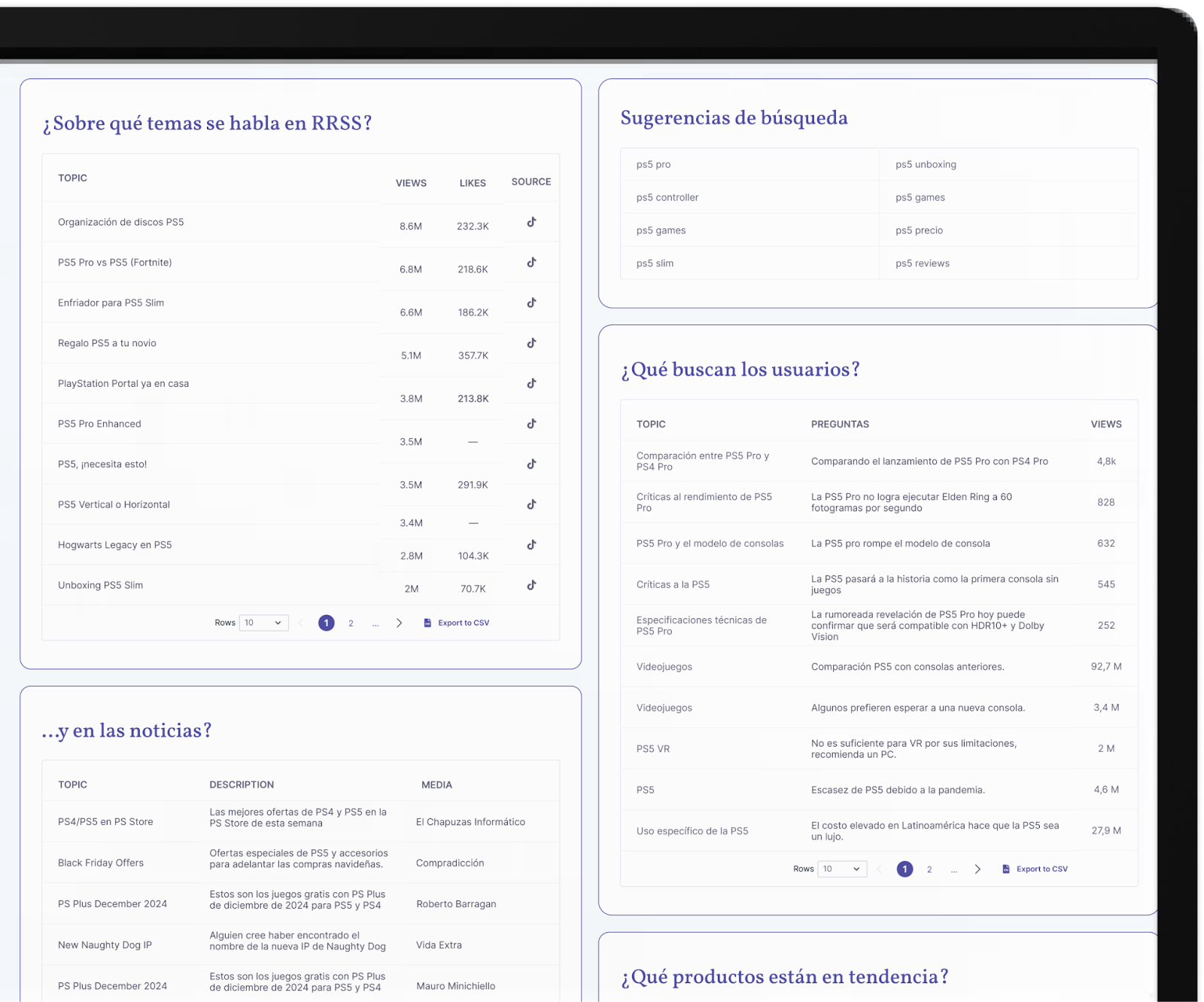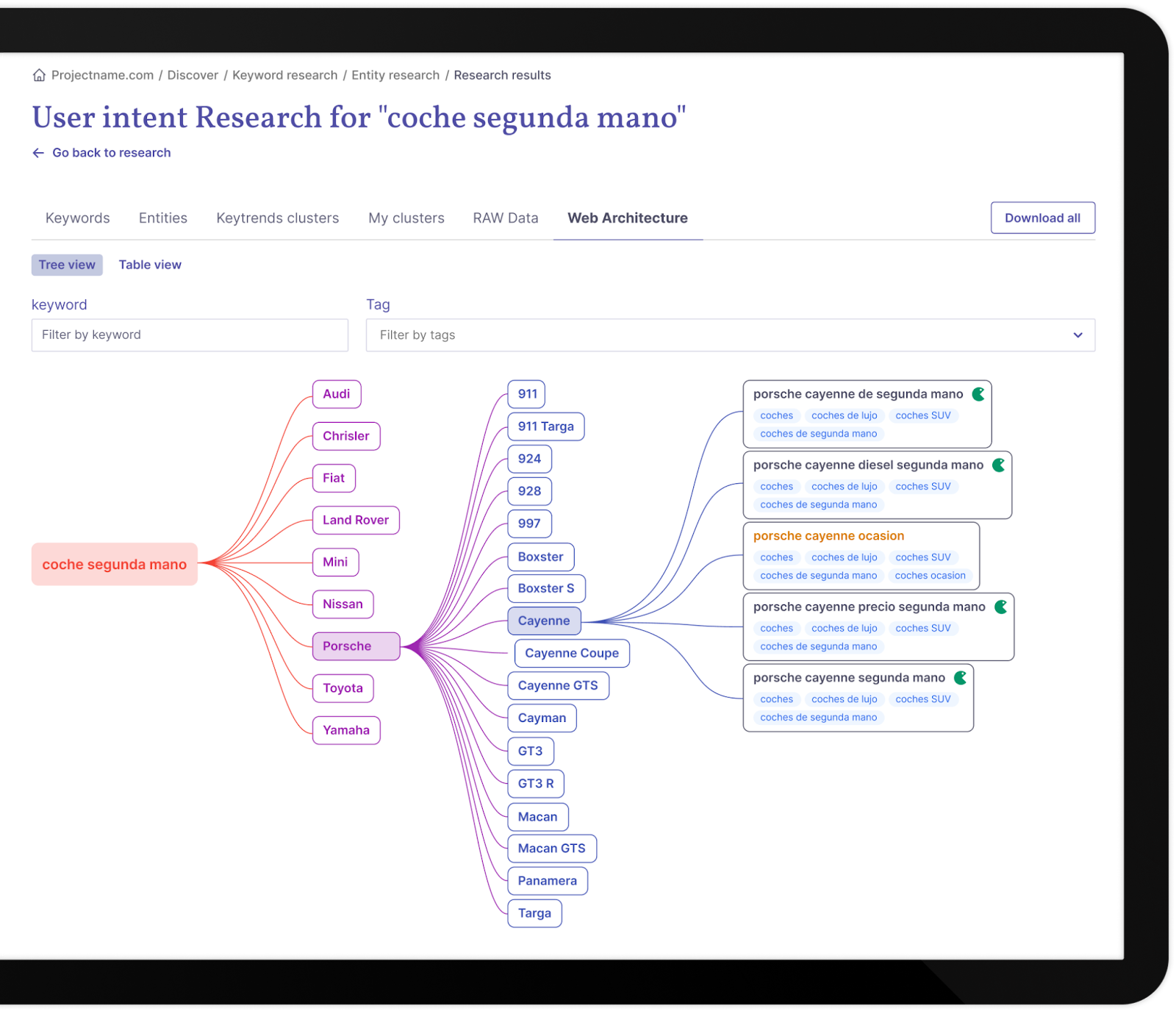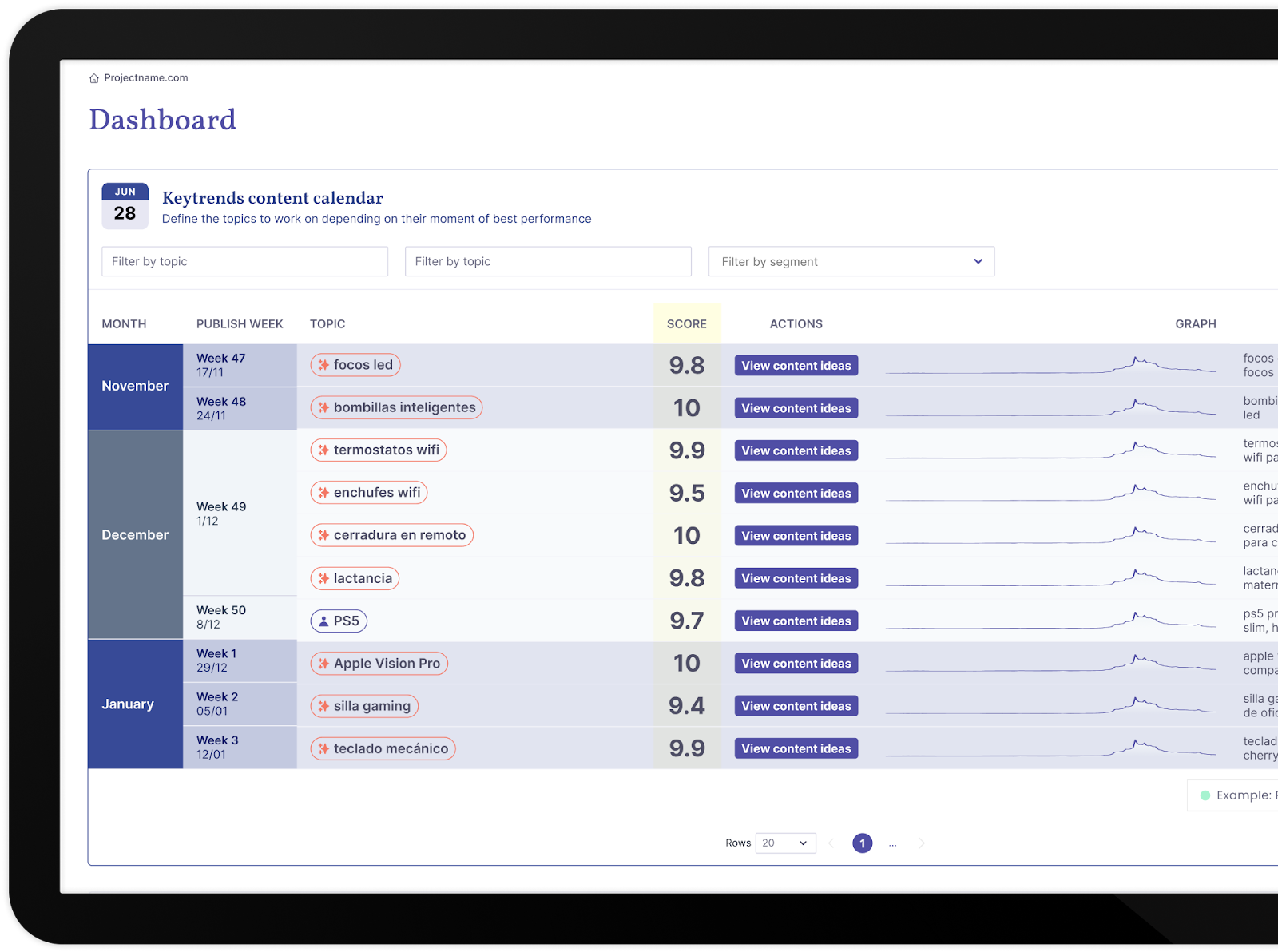Multichannel Strategy and Keyword Research: How to Master Visibility Across All Channels
Tabla de Contenidos
by
Introduction to Multichannel Marketing and Keyword Research
Marketing continues to evolve, and today’s audience fragmentation has made traditional strategies insufficient in the digital world. Multichannel marketing allows brands to interact with users through various touchpoints: search engines, social media, paid advertising, and marketplaces.
One of the key elements of current strategies is multichannel keyword research, a crucial component that helps ensure content aligns with user intent on each platform.
Multichannel Keyword Research is an advanced SEO and content creation strategy that involves researching and optimizing keywords across multiple digital platforms.
Unlike simple Keyword Research, the multichannel approach does not focus solely on traditional search engines like Google but also considers social media, marketplaces, and other important digital channels in the social conversation.

Importance of Keyword Research in a Multichannel Strategy
Improve Visibility Across Multiple Channels
Keyword Research allows us to find the most relevant keywords for each digital channel. In the case of search engines like Google, they use sophisticated algorithms to index and rank content based on its relevance. By using the right keywords, it’s possible to significantly improve ranking in search results, thus increasing brand visibility.
For social media platforms like Instagram, TikTok, or LinkedIn, using relevant hashtags or terms in posts and descriptions helps improve the organic reach of the posts.
In marketplaces like Amazon or eBay, the right keywords influence product indexing, making it easier for buyers to discover our products. Therefore, it is essential to consider each channel individually and apply an adapted keyword strategy, allowing brands to maximize their digital presence.
Align Content with User Intent
It is essential to understand that each digital platform has its own dynamics and type of audience. For example, users searching on Google may have either an informational or transactional intent, while on social media, they may be exploring more visual or interactive content.
Through keyword research, we can identify patterns and create content aligned with user expectations. An effective strategy considers not only the most searched keywords but also the intent behind them: informational, commercial, navigational, or transactional (Goodman, 2021).
Adapting content to user intent enhances the experience and conversion rate, as users find exactly what they are looking for.
Optimize SEO and SEM
SEO (Search Engine Optimization) and SEM (Search Engine Marketing) are the pillars of any digital strategy. While SEO focuses on improving organic visibility through optimized content and linking techniques, SEM relies on paid advertising strategies like Google Ads or Meta Ads.
Keyword Research is the foundation for both disciplines. In SEO, it allows for developing content aligned with user searches, using keywords in titles, descriptions, and image alt tags. In SEM, it helps select the most effective keywords for paid campaigns, optimizing the budget and maximizing return on investment (ROI) (Clarke, 2020). Without proper keyword research, SEO and SEM strategies can lead to wasted efforts and unnecessary costs.
SEO, SEM, and Social Media: A Connected Ecosystem
By using Keyword Research in an integrated way, digital marketing teams can generate SEO-optimized content in their social media posts while also selecting the best keywords for SEM campaigns. This creates an ecosystem where organic and paid visibility complement each other, increasing conversion opportunities and reinforcing brand presence across all channels.
For an effective multichannel strategy, it’s essential to understand the relationship between SEO, SEM, and social media:
- SEO: Optimizes content for search engines, ensuring strong organic positioning.
- SEM: Paid advertising captures immediate traffic and complements SEO with high-impact campaigns.
- Social Media: Acts as a key distribution channel, where keywords in hashtags, descriptions, and posts can enhance visibility.
The result: more cohesive and effective strategies that make the most of SEO, SEM, and social media, aligning all efforts towards common goals.
Increase Traffic and Conversions
By using relevant and high-performing keywords, brands can attract qualified traffic to their digital platforms. A study by Shrefs (2023) reveals that 90% of websites do not receive organic traffic due to poor keyword optimization.
The right keywords not only generate visits but also improve conversion rates. When the content matches user intent, they are more likely to take actions such as subscribing to a newsletter, making a purchase, or filling out a form (Fishkin, 2022). Keyword-based content optimization not only impacts traffic volume but also its quality, attracting users who are more likely to convert into customers.
Facilitate Data-Driven Decision Making
Keyword Research not only helps define an effective content strategy but also provides valuable data on search trends and consumer behavior. Tools like Google Trends or Keytrends allow the analysis of search volume, competition, and keyword evolution over time.
This data enables adjustments to the digital marketing strategy, focusing on terms with the highest potential and avoiding unnecessary efforts on low-performing keywords. Continuous keyword analysis helps brands stay competitive in an ever-changing digital environment.
Steps to Perform Multichannel Keyword Research
Identifying Business Priorities and ICP: Who Are You Targeting and What Are You Trying to Achieve?
It is essential to clearly define who your content is targeting and what your business objectives are. The keyword research strategy should be aligned with your business needs and your audience’s profile. To do this, it is crucial to define the Ideal Customer Profile (ICP), which refers to the type of customer who truly has the potential to benefit from your offering and drive conversions.
We should consider aspects such as:
- Demographics and Digital Behavior: Who is your ideal customer? How do they search for information online? What type of content do they consume and in what format?
- Needs and Pain Points: Identifying the problems your audience faces will allow you to tailor your content to solve them.
- Funnel Stage: Capturing users in the discovery phase is different from capturing users in the purchase intent phase. Determining this stage will help you define the types of keywords to focus on.
By establishing these foundations from the start, we can focus our keyword research more strategically and ensure that our content truly contributes to the company’s business objectives.
Identifying Platforms: Where Is Your Audience?
Once you’ve defined your audience profile and business objectives, it’s time to analyze which platforms your audience is on. We must understand that not all social media or search engines work the same way and therefore attract different types of users. This in-depth analysis of your audience’s behavior will help you determine which channels to focus your strategy on.
- Social Media: If your audience is younger, platforms like TikTok and Instagram might be ideal. For a more professional audience, LinkedIn will be a better option.

- Video Platforms: YouTube and TikTok are great for educational or entertainment-focused video content.
- Forums and Communities: Spaces like Reddit and Quora can be key for specific niches.
Each channel has its own dynamics, so understanding them well will allow us to adapt our content strategy and ensure our keywords align with user behavior on each platform.
Keyword Research: The Key to Being Relevant
Once we’ve identified the relevant platforms, the next step is keyword research. This will help us understand the terms our audience is using. To do this, we can rely on specialized tools like KeyTrends, which automates trend detection and makes it easier to identify opportunities.
Some key aspects in keyword research include:
- Search Volume: Identify terms with a good balance between popularity and competition.
- Search Intent: Understand if users are looking for information, comparing products, or ready to buy.
- Trends: Analyze how searches change over time to stay ahead of your audience’s needs.

- Long-Tail Keywords: Focus on more specific phrases that can attract highly qualified traffic.
With this information, you can develop a content strategy that is not only relevant but also more likely to rank in search results. The content should be personalized for each channel. It’s essential to adapt the tone, format, and optimization strategies according to the platform.
Content Creation: Tailor Your Message to Each Channel
The next step is to produce content optimized for each platform. It’s not enough to identify keywords; it’s essential to integrate them naturally into formats tailored to each channel.
Some key tips for creating optimized content include:
- SEO for Blogs and Websites: It’s recommended to include keywords in titles, meta descriptions, and within the content strategically, without falling into keyword stuffing.
- Social Media:
- TikTok and Instagram work best with engaging visual content and direct messages.
- LinkedIn is ideal for more elaborate articles and professional-focused posts.
- Twitter allows for quick insights through informational threads.
- Videos: On platforms like YouTube, it’s important to optimize titles, descriptions, and tags to improve visibility.
- Paid Advertising: In Google Ads and Meta Ads, selecting the right keywords is crucial for ads to reach the correct audience and achieve a good return on investment.
Each platform has its own language and type of content, so adapting the message is key to maximizing the impact of our keyword strategy.
Publishing, Measuring, and Optimizing: The Process Never Ends
A keyword research strategy doesn’t end with the publication of content; it is an ongoing process. Measurement and optimization are essential to ensure that our actions are generating the expected results and to adjust them if necessary.
To do this, we should:
- Analyze key metrics: Use tools like Google Analytics, Search Console, and KeyTrends to measure CTR, conversions, time on page, and social media interactions.
- Identify improvement opportunities: If a keyword is not generating traffic or conversions, it’s important to analyze whether it needs adjustments in the content strategy.
- Adjust based on trends: User behavior constantly changes, so monitoring trends and updating our content accordingly will allow us to stay competitive.
By following these steps, we can develop an effective Multichannel Keyword Research strategy, aligned with business goals and optimized for each platform.
Tools for Multichannel Keyword Research
As we’ve seen, keyword research is one of the fundamental strategies in digital marketing. Therefore, we need to analyze the essential tools to get the most out of each channel, highlighting their features and how they can help you develop an effective strategy.
Keytrends: The All-in-One Solution for Multichannel Keyword Research
KeyTrends is a platform designed to automate content strategy and facilitate decision-making in digital marketing. Its technology enables:
- Research keywords from multiple sources, including Google, Reddit, YouTube, and Instagram, to gain a more comprehensive view of the market.

- Detect real-time trends, identifying opportunities before they become saturated, and allowing for agile content strategy adjustments.
- Optimize content for SEO, ensuring that each post meets positioning criteria and increases its visibility in search engines.

- Create content for websites and social media, facilitating the generation of articles, product descriptions, and posts optimized for different channels.

A key tool for marketing, SEO, and social media teams looking to improve their strategy without wasting time on manual tasks.
Other Tools
Semrush: SEO Analysis and Digital Marketing in One Platform
Semrush is one of the most comprehensive tools on the market for SEO and digital marketing. Its powerful analysis engine allows you to:
- Conduct keyword research with detailed metrics on search volume, difficulty, and competition.
- Analyze competitors’ SEO strategies, discovering which keywords they are ranking for and how they optimize their content.
- Perform website audits to detect technical errors that may affect performance in search engines.
- Optimize PPC (pay-per-click) campaigns with precise information about the most profitable terms.
Ahrefs: The Leading Tool for Backlinks and Technical SEO
Ahrefs is widely recognized for its ability to analyze incoming links (backlinks), making it one of the favorites among SEO experts. Its main features include:
- Site Explorer to analyze the traffic and authority of a domain.
- Keyword research with detailed metrics and ranking difficulty.
- SEO audit to identify technical issues and suggest improvements.
- Analysis of broken links and link-building opportunities to strengthen off-page SEO strategy.
Keyword Insights: Optimization Based on Search Intent
Keyword Insights focuses on helping content specialists create strategies based on advanced keyword data. What makes it special is its ability to:
- Group keywords into clusters to facilitate content planning.
- Identify user search intent (informational, commercial, transactional, etc.).
- Suggest content opportunities using AI, optimizing the structure of each article to improve ranking.
Sistrix: Visibility and Performance Analysis on Google
Sistrix is an advanced SEO platform specializing in analyzing the organic visibility of a website in search engines. Its key features include:
- Visibility Index: measures the performance of a domain in Google search results.
- Competitor analysis to discover which strategies are working best in the industry.
- Monitoring of trends and changes in Google’s algorithms that may affect a website’s ranking.
- Evaluation of keyword and specific page performance.
Adaptation of Keywords for Different Channels
In the world of digital marketing, it’s essential to understand that each channel has its own characteristics, audiences, and objectives. Therefore, depending on our goal, we will use one channel or another. And while it may seem like an insignificant decision, it is one of the key factors that will allow you to reach and attract your audience.
SEO (Search Engines)
Search engine optimization (SEO) is essential for improving visibility and organic traffic to your website. In this context, keywords play a crucial role. For SEO, it’s recommended to focus on keywords with high search volume and clear search intent. This means selecting terms that users frequently search for and that reflect a specific intent, such as purchasing a product, obtaining information, or taking action.
Redes sociales
Las redes sociales son plataformas dinámicas y de rápido movimiento, donde la interacción y el compromiso con la audiencia son esenciales. Aquí, las palabras clave deben adaptarse a un estilo más conversacional y natural, utilizando hashtags relevantes para aumentar el alcance y la visibilidad. En el caso de las redes sociales más visuales es fundamental acompañar las keywords con contenido visual atractivo, cómo imágenes, videos o infografías que ayuden a captar la atención del cliente.
PPC (Pay-Per-Click Advertising)
Pay-per-click (PPC) advertising is a powerful strategy to generate immediate and targeted traffic. In this case, the selection of keywords should focus on terms with high conversion rates that align with users’ purchase intent. It is important to identify and select keywords that not only generate clicks but also have a high likelihood of conversion.
Email marketing and internal content
Email marketing and internal content, such as blogs and articles, are important channels for maintaining relationships with your customers and improving their experience. The natural integration of keywords in these media is essential to maintain relevance and user interest.
Attribution and mentions: improving the multichannel strategy.
Attribution in digital marketing is essential for understanding how different channels contribute to a conversion or sale. Since users interact with brands across multiple touchpoints (SEO, social media, PPC, email marketing), it’s important to be able to measure which channels are generating the best results. This allows brands to optimize their resources and maximize their return on investment (ROI).
It is important to understand that this attribution refers to the process of tracking all interactions a customer has with your brand across various channels. Attribution models determine how credit for sales and conversions is assigned to different touchpoints in the customer journey.
There are several attribution models, such as the last-click model, which assigns all credit to the final interaction, or the linear attribution model, which distributes credit equally across all touchpoints. By applying an appropriate attribution model, you can gain valuable insights to improve your multichannel strategy, as well as optimize keyword selection across these channels.
Additionally, mentions of your brand on trusted sites, whether by influencers, media outlets, or on social media, play a key role in building brand authority and SEO. These mentions not only contribute to improving visibility, but also build trust with your audience, leading to a higher likelihood of conversion.
Remember, the key is to adapt, learn, and continuously adjust to reflect the ever-changing reality of consumer behavior.
Measurement and Analysis of Results
In marketing, after each action, we must measure and analyze the results we are achieving to know if what we are doing is working correctly or if we need to change something. In the case of a multichannel keyword research strategy, it is essential to constantly measure performance. This involves using various tools and key metrics that provide a comprehensive view of the impact of keywords on your digital marketing strategy.

Key Metrics and Conversions to Monitor
- CTR (Click-Through Rate): measures the click-through rate relative to impressions. This metric indicates the effectiveness of keywords in attracting clicks. A high CTR suggests that the keywords and ads are relevant and engaging for users.
- Search Engine Ranking: allows you to know your website’s visibility on search engines. Monitoring the ranking of your keywords helps you understand how your content ranks against the competition.
- Conversion Rate: indicates how many users take a desired action after clicking on a link. This can include completing a purchase, subscribing to a newsletter, or filling out a contact form. A high conversion rate indicates that the keywords are attracting the right audience and that the content is persuasive.
- Social Media Engagement: evaluates the interaction generated on platforms such as Facebook, LinkedIn, and Instagram. Engagement metrics include “likes,” comments, shares, and clicks on links. A high level of engagement suggests that the content resonates well with the audience.
Future Trends in Multichannel Marketing
AI and Automation: Real-Time Data-Driven Personalization
The use of artificial intelligence in multichannel marketing is revolutionizing the way brands interact with their audiences. Thanks to automation, companies can analyze large volumes of data in real time to deliver hyper-personalized content. AI tools allow businesses to predict user preferences, optimize segmentation strategies, and enhance the customer experience. Chatbots, virtual assistants, and marketing automation platforms are reducing the operational burden on teams, enabling more effective and personalized communication at every stage of the customer journey.
Mobile Marketing and SMS: Increase in the use of strategies focused on mobile devices.
The growth of mobile device usage has made mobile marketing a key strategy to reach consumers at the right time and place. With the increase in smartphone usage, brands are implementing strategies based on push notifications, SMS, and mobile apps to generate instant interactions with users. Additionally, geolocation campaigns and programmatic advertising allow brands to target potential customers with personalized offers and messages based on their location and browsing behavior.
Predictive Segmentation: Using algorithms to predict behaviors and optimize strategies.
Predictive segmentation is revolutionizing digital marketing by allowing brands to anticipate consumer needs and desires before they are expressed. Thanks to machine learning and advanced data analysis, companies can identify behavior patterns and predict what type of content, product, or message will be most effective for each segment of their audience. This trend not only optimizes content personalization but also improves the allocation of advertising budgets and customer retention by offering highly relevant experiences tailored to each user in their buying journey.
Bibliography
- Acceseo. (n.d.). Medición multicanal y atribución avanzada. Acceseo. https://www.acceseo.com/medicion-multicanal-y-atribucion-avanzada.html
- Cyberclick. (s.f.). El nuevo horizonte del SEO: Estrategias multicanal para triunfar en un mundo impulsado por IA. https://www.cyberclick.es/numerical-blog/el-nuevo-horizonte-de-seo-estrategias-multicanal-para-triunfar-en-un-mundo-impulsado-por-ia
- Consultoría MKT. (s.f.). Estrategias de SEO multicanal. https://consultoriamkt.com/estrategias-de-seo-multicanal/
- Moz. (2023). The Beginner’s Guide to SEO. Retrieved from https://moz.com/beginners-guide-to-seo
- Ahrefs. (2023). How to Rank on Google: A Study of 2 Million Keywords. Retrieved from https://ahrefs.com/blog/
- Chaffey, D., & Smith, P. R. (2022). Digital Marketing Excellence: Planning, Optimizing and Integrating Online Marketing. Routledge
- Google. (2024). SEO Starter Guide. Google Search Central.
- HubSpot. (2024). Keyword Research for SEO: A Beginner’s Guide. HubSpot Blog.
- Moz. (2024). The Beginner’s Guide to SEO. Moz.



